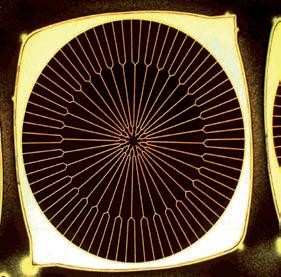LayTec is happy to announce that the German Federal Ministry of Economics and Technology has approved funding for the development of a new insitu sensor for the photovoltaic market! In collaboration with the Fraunhofer Institute for Solar Energy Systems (ISE), Germany, a research project has been launched to improve the in-situ monitoring of MOVPE processes for triple-junction photovoltaic cells being developed at Fraunhofer ISE.
 Concentrator solar cell with an efficiency of 39,7 % at C = 300 developed at Fraunhofer ISE
Concentrator solar cell with an efficiency of 39,7 % at C = 300 developed at Fraunhofer ISE
The cooperation between LayTec and the "III-V- Epitaxy and Solar Cells" group is aimed to develop monitoring sensors for industrial-scale manufacturing of triple-junction solar cells with improved process control in multi-wafer MOVPE reactors. "Real-time analysis and control of our processes is becoming a key for the development of complex semiconductor structures such as multi-junction solar cells" says Dr. Frank Dimroth from Fraunhofer ISE, "We are proud to collaborate with LayTec to improve the capability of their in-situ sensor for our specific application".
ISE’s cells are the most efficient produced in Europe today. ISE transfers its process technology to the cooperation partner Azur SSP, who prepares them for commercial production. ISE and Azur SSP use AIXTRON Planetary® systems both for development and manufacturing. LayTec’s EpiCurve®TT sensor, which has already become the bestseller on the MOCVD LED market, will be further improved to achieve the resolution necessary for multi-junction solar cell growth under the conditions of planetary rotation. In addition to temperature, layer thickness and strain measurements, the new sensor will determine the composition and help to better understand the reasons for dislocations and strain within the layers. This will help to compensate for strain induced temperature inhomogeneities, to determine the thickness of individual thin layers and to monitor the composition of critical heterojunctions.